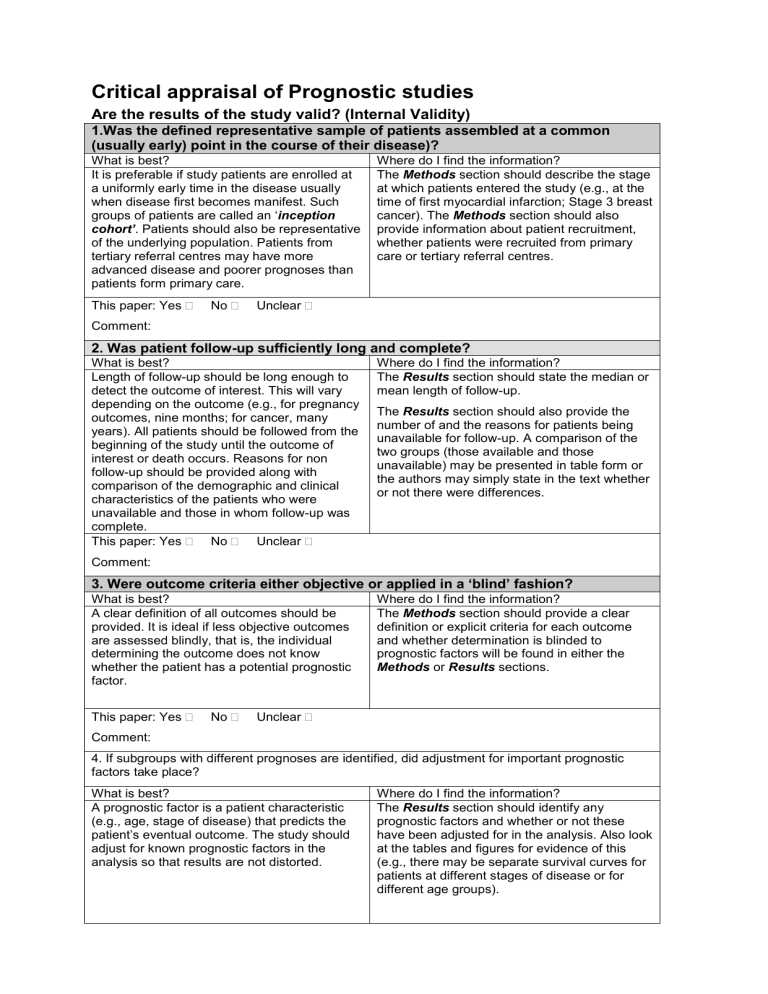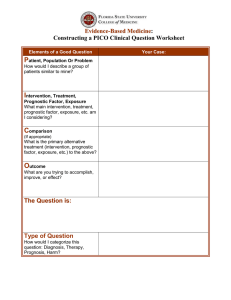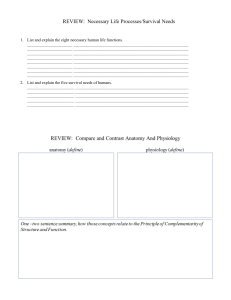
Critical appraisal of Prognostic studies Are the results of the study valid? (Internal Validity) 1.Was the defined representative sample of patients assembled at a common (usually early) point in the course of their disease)? What is best? It is preferable if study patients are enrolled at a uniformly early time in the disease usually when disease first becomes manifest. Such groups of patients are called an ‘inception cohort’. Patients should also be representative of the underlying population. Patients from tertiary referral centres may have more advanced disease and poorer prognoses than patients form primary care. This paper: Yes No Where do I find the information? The Methods section should describe the stage at which patients entered the study (e.g., at the time of first myocardial infarction; Stage 3 breast cancer). The Methods section should also provide information about patient recruitment, whether patients were recruited from primary care or tertiary referral centres. Unclear Comment: 2. Was patient follow-up sufficiently long and complete? What is best? Length of follow-up should be long enough to detect the outcome of interest. This will vary depending on the outcome (e.g., for pregnancy outcomes, nine months; for cancer, many years). All patients should be followed from the beginning of the study until the outcome of interest or death occurs. Reasons for non follow-up should be provided along with comparison of the demographic and clinical characteristics of the patients who were unavailable and those in whom follow-up was complete. This paper: Yes No Unclear Where do I find the information? The Results section should state the median or mean length of follow-up. The Results section should also provide the number of and the reasons for patients being unavailable for follow-up. A comparison of the two groups (those available and those unavailable) may be presented in table form or the authors may simply state in the text whether or not there were differences. Comment: 3. Were outcome criteria either objective or applied in a ‘blind’ fashion? What is best? A clear definition of all outcomes should be provided. It is ideal if less objective outcomes are assessed blindly, that is, the individual determining the outcome does not know whether the patient has a potential prognostic factor. This paper: Yes No Where do I find the information? The Methods section should provide a clear definition or explicit criteria for each outcome and whether determination is blinded to prognostic factors will be found in either the Methods or Results sections. Unclear Comment: 4. If subgroups with different prognoses are identified, did adjustment for important prognostic factors take place? What is best? A prognostic factor is a patient characteristic (e.g., age, stage of disease) that predicts the patient’s eventual outcome. The study should adjust for known prognostic factors in the analysis so that results are not distorted. Where do I find the information? The Results section should identify any prognostic factors and whether or not these have been adjusted for in the analysis. Also look at the tables and figures for evidence of this (e.g., there may be separate survival curves for patients at different stages of disease or for different age groups). Centre for Evidence-Based Medicine, University of Oxford, 2010 This paper: Yes No Unclear Comment: What are the results? How likely are the outcomes over time? There are several different ways of reporting outcomes of disease. Often they are reported simply as a rate (e.g., the proportion of people experiencing an event). Expressing prognosis as a rate has some advantages. It is simple, easily communicated and understood and readily committed to memory. Unfortunately, rates convey very little information and there can be important differences in prognosis within similar summary rates. For this reason survival curve are used to estimate survival of a cohort over time. It is a useful method for describing any dichotomous outcome (not just survival) that occurs only once during the follow-up period, The figure below shows the survival curves for three diseases with the same survival rate at 5 years. Notice that the summary rate obscures important differences to patients Figure. Five year curves for three different diseases. How precise are the prognostic estimates? To determine the precision of the estimates we need to look at the 95% confidence intervals (CI) around the estimate. The narrower the CI, the more useful the estimate. The precision of the estimates depends on the number of observations on which the estimate is based. Since earlier follow-up periods usually include results from more patients than later periods, estimates on the left hand side of the curve are usually more precise. Observations on the right or tail end of the curve are usually based on a very small number of people because of deaths, dropouts and late entrants to the study. Consequently, estimates of survival at the end of the follow-up period are relatively imprecise and can be affected by what happens to only a few people. Can I apply this valid, important evidence about prognosis to my patient? The questions that you should ask before you decide to apply the results of the study to your patients are: Is my patient so different to those in the study that the results cannot apply? Will this evidence make a clinically important impact on my conclusions about what to offer to tell my patients Centre for Evidence-Based Medicine, University of Oxford, 2010 Centre for Evidence-Based Medicine, University of Oxford, 2010 Centre for Evidence-Based Medicine, University of Oxford, 2010

